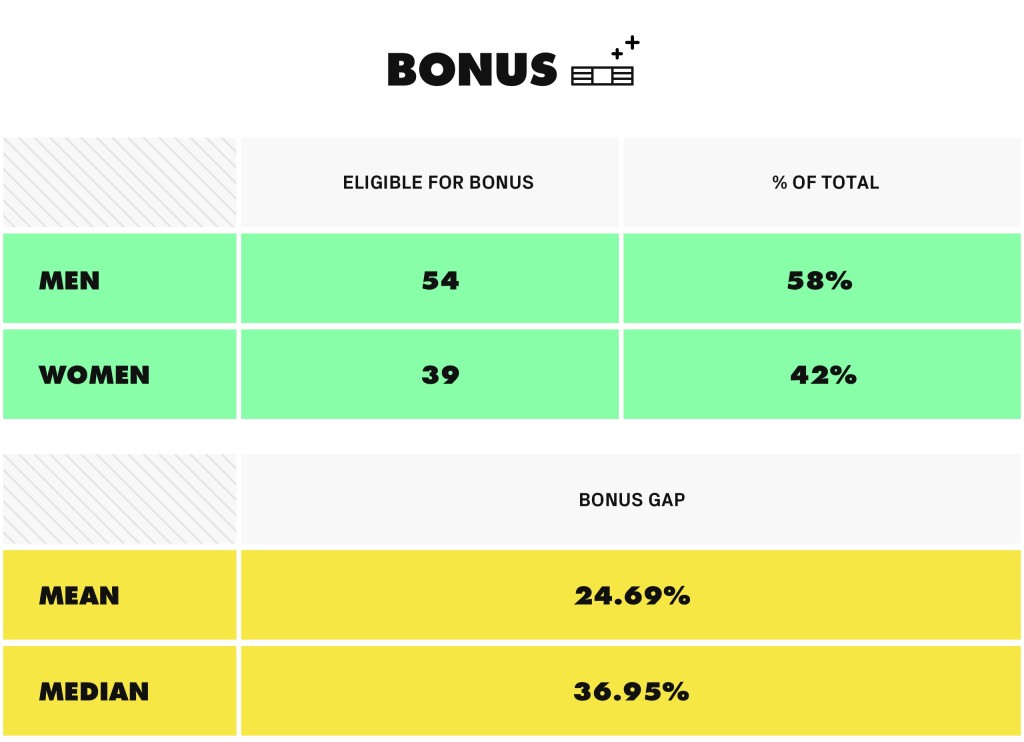So the gender pay gap results are in – 78% of UK firms pay men more than women. There was no sector that paid women more than men on average and the data showed that women are being paid a median hourly rate that’s 9.7% less than that given their male colleagues.
Well, that’s from the 10,014 companies with 250 employees or more who submitted their reports in time. Some 1,500 firms missed the 4 April deadline to report their gender pay gap results and now face legal action. One wonders what they have to hide.
As with last year, we want to share our gender pay analysis. We believe it’s important that all organisations publish data on their gender pay gaps, even when they don’t have to. It matters on multiple levels – it matters to the industry, as it needs to change, and is important within the business itself. Transparency on this issue is the start of the journey. Without it we can’t talk about what we all need to do to improve and what we will do to improve it.
At ustwo London, we’re well aware that we still have fewer women in our lead roles. And it’s a problem we’re working on because ultimately we want everyone to have equal access to the same higher-paying roles. Our ambition for better diversity and inclusion across our studio goes beyond gender and pay.
As we publish today, we invite more UK studios, agencies and consultancies across the design, product, and tech industries to publish their gender pay gap data and begin a conversation that urgently needs to happen.
Our pay gap has gone down 1% from last year to 2.46% as a result of initiatives we’ve put in place. Within our industries and related industries, we should be proud. And to put the figures into a wider context, airline Ryanair had one of the biggest differences with a 71.8% gender pay gap. But, of course, there is always more for us to do.
Below we’re sharing further statistics following the legally mandated method of reporting:



Taking steps
At ustwo London, we have tried to systematically look at pay and reward; inclusion; talent management and people development.
Here are the things we have managed to do since we last reported on our gender pay gap in April 2017:
- Management training
We piloted manager training for new managers; we will be rolling out manager training as a programme this year. Understanding our biases and how to support all individuals in their progression is key to tackling any gender pay gaps.
- Better family-friendly policies
We launched our equal paid parental leave policy last summer. We’re firm believers in supporting all parents, irrespective of gender or family circumstance to balance their careers. We made the seismic step to offer equal fully paid parental leave for new parents for six months as we recognise it’s key to closing the gender pay gap. We know men want a more equal share when it comes to childcare, so we have enabled that.
Society cannot change the way parenting works and challenge historical negative cultural assumptions about gender roles without employers supporting fathers to take time to care for their children, ultimately enabling women to lean back into their careers.
- Recruitment and talent development
We are still pushing for 50/50 shortlists, especially from recruiters. We’re proud that our Leadership team is made up of two women and three men. We have also now formalised two yearly reviews and opportunity for individuals to articulate their progression and have their pay reviewed.
We’ve piloted our own Under-represented in leadership training in partnership with leadership coach Harriet Minter: Nine people have been through the training to date and we’re about to start our next round. The criteria for being part of the training is not gender-specific but we identify people from under-represented groups in the studio and coach them about their goals and teach them about the business. Our aim is for the next generation of company leaders to be from a broader background still.
More work required
We’re proud of some of the things we’ve improved, while recognising we have some way to go to ensure that we have a diverse and inclusive studio. Here are the things we’ve not managed to do to improve diversity and gender pay and which we will address by close of 2018 as a priority.
- Progression framework for business supporting roles
This is something we failed to tackle this year. Now that our Chief People Officer, Sinead Ryan, is here, we are prioritising ensuring that the framework is consistent across all roles and studios and ultimately incorporates all business supporting roles.
- Flexible working
This is something we haven’t nailed yet and we know we need to do better. We’re going to focus on how we make returning to work for new parents easier, improve flexible practices and improve the way we provide long-term family support. We also want to see an increase in number of people working non-standard hours.
Ideally, more of our jobs can have smarter flexible working – we will have a real focus on improving these numbers. Term time working may be one solution to this – we will explore different options.
- Unconscious bias training
Research has shown time and again that women are discriminated against when they ask for a rise. We will start unconscious bias training again and ensure all our managers are aware of the inherent biases we all bring. The most recent study in 2016 showed that women actually ask for pay rises as often as men, but receive them less. Research by the University of Wisconsin in the US and the University of Warwick and Cass Business School in the UK found men were 25% more likely than women to get a pay rise when they asked. One of the study’s authors concluded that it showed women were subject to “pure discrimination” – and that’s before you even get bias and even unconscious bias against women in the workplace. We need to help all our managers and leaders better recognise this inherent bias.
A final word
Beyond our gender pay gap, we believe it’s important to state that a conversation also needs to be had and data revealed about pay gaps beyond gender. The gender pay gap debate doesn’t account for those individuals who self-identify as non-binary gender or transgender. We all need to get better at reporting on this as well, coupled with drilling down into factors such as ethnicity, disability, aged, socio-economic background, class and more. If we are to truly embrace diversity and reward everyone equally, we need to harvest and publish data that goes beyond mere binary genders.
But we also need to ensure that we are tackling diversity across the board in our industry – that with our ongoing conversation about gender, we don’t lose sight of truly embracing diversity when it comes to age, ethnicity, disability, class and sexuality.
So, let’s all focus on doing better and creating more inclusive and diverse workforces in our industry.
This post has been co-written by Chief People Officer Sinead and London’s Managing Director Nicki. You can contact either of them to further this conversation: sinead@ustwo.com and nicki@ustwo.com.
